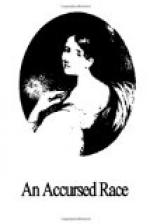As any intermarriage with the pure race was strictly forbidden, and as there were books kept in every commune in which the names and habitations of the reputed Cagots were written, these unfortunate people had no hope of ever becoming blended with the rest of the population. Did a Cagot marriage take place, the couple were serenaded with satirical songs. They also had minstrels, and many of their romances are still current in Brittany; but they did not attempt to make any reprisals of satire or abuse. Their disposition was amiable, and their intelligence great. Indeed, it required both these qualities, and their great love of mechanical labour, to make their lives tolerable.
At last, they began to petition that they might receive some protection from the laws; and, towards the end of the seventeenth century, the judicial power took their side. But they gained little by this. Law could not prevail against custom: and, in the ten or twenty years just preceding the first French revolution, the prejudice in France against the Cagots amounted to fierce and positive abhorrence.
At the beginning of the sixteenth century, the Cagots of Navarre complained to the Pope, that they were excluded from the fellowship of men, and accursed by the Church, because their ancestors had given help to a certain Count Raymond of Toulouse in his revolt against the Holy See. They entreated his holiness not to visit upon them the sins of their fathers. The Pope issued a bull on the thirteenth of May, fifteen hundred and fifteen—ordering them to be well-treated and to be admitted to the same privileges as other men. He charged Don Juan de Santa Maria of Pampeluna to see to the execution of this bull. But Don Juan was slow to help, and the poor Spanish Cagots grew impatient, and resolved to try the secular power. They accordingly applied to the Cortes of Navarre, and were opposed on a variety of grounds. First, it was stated that their ancestors had had “nothing to do with Raymond Count of Toulouse, or with any such knightly personage; that they were in fact descendants of Gehazi, servant of Elisha (second book of Kings, fifth chapter, twenty-seventh verse), who had been accursed by his master for his fraud upon Naaman, and doomed, he and his descendants, to be lepers for evermore. Name, Cagots or Gahets; Gahets, Gehazites. What can be more clear? And if that is not enough, and you tell us that the Cagots are not lepers now; we reply that there are two kinds of leprosy, one perceptible and the other imperceptible,




